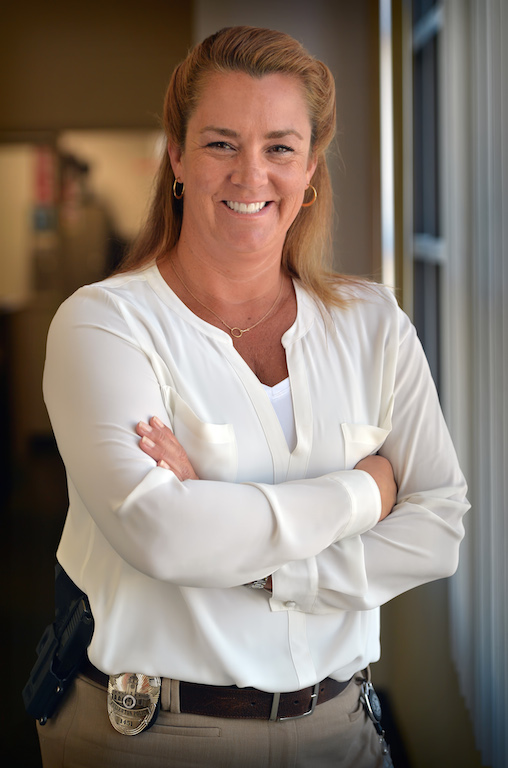We live in a digital world. Our work, personal life and even educational system rely on the quick and efficient transfer of information and connectivity that our laptops, cell phones and other gadgets afford us.
But there is a dark side to this high-speed world – and our children often are at risk.
“I think what we’re seeing … is much more misuse by juveniles in sending inappropriate pictures and inappropriate content to one another,” says Det. Carin Wright, a member of the Fullerton Police Department’s Family Crime Unit.
Two big threats currently being seen by the FPD Family Crime Unit and the agency’s school resource officers are cyberbullying and the transmission of sexually explicit photos among youth.
Sending sexually explicit photos is a crime
Wright says many kids don’t realize sending a “naked selfie” to their boyfriend or girlfriend is actually against the law – but state penal code 311 specifically addresses electronically sending obscene matter involving a minor. Beyond that, they don’t understand the intractable nature of these images once they are out there – and how quickly an inappropriate photo or video sent to a friend can quickly spread from phone to phone.
“Now you have this unattainable, unrecoverable image out in cyberspace,” Wright says. “It’s an uncontrollable world out there.”
And not only can such photos be shared throughout schools and school districts, but they also can end up in very wrong hands, including sex predators and child porn collectors.
“It just becomes an avalanche of people involved,” Wright says.
Wright says some students mistakenly think using a temporary social media forum such as Snapchat, which disappears in seconds, will save them from having their image shared. Not the case, says Wright, because there always are screenshots or apps that can save the content.
“Now you have these images being preserved permanently,” she says.
FPD School Resource Officer Cpl. Gabby Soto says the transmission of pornographic images is a big trend right now among middle school students and also at the high school level.
“What they need to understand is that it is considered child pornography as they are under age,” says Soto. “Both the sender and the receiver can be arrested for possession/distribution of such images. Once they go to court, it’s up to the judge what they get as a sentence, whether it is counseling or classes, depending on the circumstances.”
Cyberbullying still a problem
Evolving technology also is impacting cyberbullying. According to Wright, because of burner phones and emails, cyberbullies can easily disguise themselves.
“[It] allows you to engage in absolute cruel bullying of other people that you absolutely wouldn’t do in person,” says Wright.
There are more and more cases helping set precedents, as well as penal code sections available for the judicial system to try and convict cyberbullies.
One large case was the 2008 Jessica Logan cyberbullying case in which Logan sent a naked photo of herself to her boyfriend at the time. When they broke up, he sent the photo to others, who then started harassing Logan. She ended up committing suicide.
Soto says FPD school resource officers are seeing cyberbullying more often than the transmission of pornographic images.
“Cyberbullying is just easier because all students have social media and make themselves accessible,” she says. “For the most part in cyberbullying cases, the victim knows who the bully is and if it’s a school-related incident, we talk to the bully and make sure that it is stopped. If it happens to be a stranger, we advise the victim to block the person, report any bullying material to the application as inappropriate, make their accounts private, or just get rid of social media altogether. Kids also need to understand that creating fake profiles or impersonating someone else could potentially get them arrested if harm is done to anyone.”
What parents can do
Adults are at a bit of a disadvantage when it comes to technology – parents and law enforcement officials are in a constant battle to keep up with what seems to come so easily to the younger generations, says Wright.
“We’re playing catch-up, we’re old school. We’re just trying to figure out the iPhone and the computer,” says Wright. “They’re a lot more advanced and knowledgeable than we are.”
Wright says parents need to educate themselves on the legalities as well as the technology of online and cellular communication. They also need to restrict access to their kids on their devices.
“Do the kids really need unsupervised [access]?” she says. “You want to know where your kids are all the time physically, wouldn’t you want to know where your kids are all the time on the Internet?”
In the case of cyberbullying, Wright suggests looking out for warning signs including changes in mood, and withdrawal from friends and social media.
“Best thing to do to avoid cyberbullying is to not have any type of social media,” says Soto. “If you are going to have it, make sure profiles are private and you only accept people that you know. Parents should also be checking their kids’ profiles to see what they are posting and who they are talking to.”
Soto says parents should talk to their kids about the legal and emotional consequences of sending pornographic images to someone, including the fact that once a nude photo is out there, it’s nearly impossible to get rid of it.
School Resource Officer Andrew Coyle says the FPD has had cases where a girl sent a photo in eighth grade and it started circulating out in her junior year.
“Parents need to have the code to these phones,” says Coyle. “They need to see the apps they have on their phones and monitor them. These kids will be on [the]phone 24/7 and all night [when]they should be sleeping.”
 Behind the Badge
Behind the Badge





